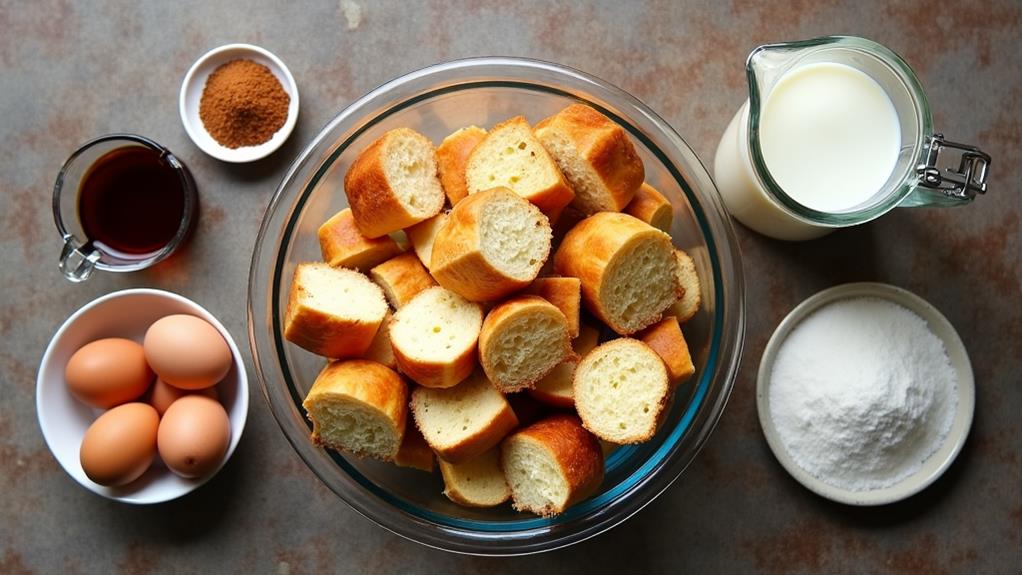When you think of bread pudding, you might picture a simple, rustic dessert, but its history reveals much more than that. Originating in 13th-century England as a resourceful way to use stale bread, this dish has evolved over centuries, adapting to various cultures and tastes. As you explore its transformation and the unique ingredients that can elevate it, you'll discover how this humble pudding has become a beloved classic in many households. What secrets does this dessert hold, and how can you make it your own?
Key Takeaways
- Bread pudding originated in 13th-century England and was designed to minimize food waste using leftover bread.
- The dessert typically features a custard base made from eggs, milk, and sugar, mixed with bread cubes.
- Common variations include adding nuts, dried fruits, chocolate chips, or spices for enhanced flavor.
- It can be served warm or cold, making it a versatile dessert suitable for any season.
- Leftovers can be stored in the refrigerator for up to three days or frozen for three months.
History
Bread pudding has a rich history that dates back to 13th-century England, where it emerged as a frugal dish known as "poor man's pudding." This creation aimed to use up leftover bread, helping people minimize food waste during tough times.
As it traveled across cultures, bread pudding evolved, adapting to local ingredients and preferences, making it a truly versatile dessert.
In the United States, especially in vibrant New Orleans, bread pudding transformed into a beloved classic. Here, it became famous for its comforting texture and delightful flavors. Traditional recipes often feature a custard base made from eggs, milk, and sugar, mixed with stale bread, raisins, and spices like cinnamon and nutmeg.
This combination not only highlights the dish's rich history but also showcases its ability to innovate.
Today, you can find countless variations of bread pudding, reflecting both its historical roots and modern culinary creativity. Whether you enjoy it warm from the oven drizzled with a rich sauce or in a unique flavor combination, bread pudding continues to be a delicious way to honor the past while embracing fresh ideas.
Recipe

Bread Pudding Recipe
Bread pudding is a delightful dessert that transforms stale bread into a warm, comforting dish. The key to a successful bread pudding lies in using the right type of bread, which should be sturdy enough to hold its shape while absorbing the custard mixture. This classic recipe features a rich custard made with eggs, milk, and sugar, combined with your choice of optional ingredients like nuts and dried fruits for added flavor and texture.
Whether served warm or cold, bread pudding is a versatile dessert that can be enjoyed any time of the year.
To begin, gather your stale bread, ideally using types such as challah, brioche, sourdough, or French bread. Cut the bread into 1-inch cubes and allow them to soak in the custard mixture for a sufficient amount of time to guarantee every piece is well-coated and flavorful. As it bakes, the bread will rise and form a deliciously soft and custardy center, making it an irresistible treat that pairs wonderfully with sauces like vanilla or bourbon.
Ingredients:
- 6 cups stale bread (challah, brioche, sourdough, or French bread)
- 4 large eggs
- 2 cups milk
- 1 cup sugar
- 1 teaspoon vanilla extract
- 1 teaspoon ground cinnamon (optional)
- 1 cup nuts (optional)
- 1 cup dried fruits (optional)
Instructions:
Preheat your oven to 350°F (175°C). In a large mixing bowl, whisk together the eggs, milk, sugar, vanilla extract, and ground cinnamon until well combined.
Place the 1-inch bread cubes in a separate large bowl, then pour the custard mixture over the bread, ensuring all pieces are soaked. Allow the mixture to sit for 20-25 minutes, letting the bread absorb the custard. If you're using nuts or dried fruits, gently fold them into the mixture.
Transfer the soaked bread mixture to a greased baking dish and bake for 50-55 minutes, or until the top is golden brown and a toothpick inserted in the center comes out clean.
Extra Tips:
For a more decadent bread pudding, consider adding chocolate chips or a splash of bourbon to the custard mixture for a rich flavor. If you have leftover bread pudding, it can be stored in the refrigerator and reheated in the oven or microwave.
Additionally, feel free to experiment with different spices such as nutmeg or cardamom for unique flavor profiles, or even swap out the milk for cream for an extra indulgent treat.
Similar dishes include rice pudding, which uses rice instead of bread, and savory bread pudding, which incorporates vegetables and cheeses for a main dish option.
Variations of bread pudding can also be found, such as chocolate bread pudding or bread pudding with a caramel sauce, showcasing the versatility of this beloved dessert.
Final Notes
When it comes to enjoying your homemade bread pudding, remember that this dessert isn't only delicious but also adaptable to your tastes. You can use stale bread like challah or brioche, which makes for a rich texture that holds up beautifully in the oven.
Don't hesitate to experiment with your custard mixture—try adding chocolate chips for an indulgent twist or a splash of bourbon for a sophisticated touch.
Once you've baked your easy bread pudding, serve it warm, drizzled with a luscious vanilla sauce or topped with whipped cream. This classic dessert truly shines at gatherings, and everyone will appreciate your creativity.
If you find you've made too much, no worries! You can store it in the refrigerator overnight for up to three days or even freeze it for up to three months. Just reheat it gently, and it'll taste like it just came out of the oven.
